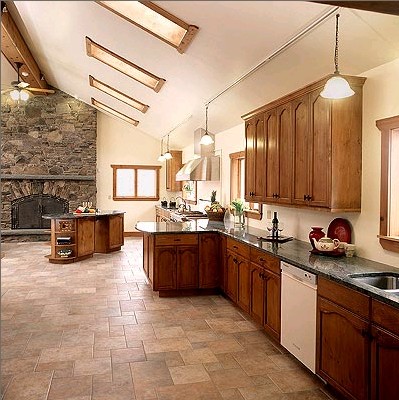 Besides the cabinets and countertop, your kitchen floor is the visually most prominent part of the kitchen. Appearances are important, however, don’t choose the material just based on looks. Think through what you will most likely need, then drive to a Floor Sales store to see for yourself. There are a host of options, let’s see what’s available…. There is also the easiest way to elevate the look of a space of your kitchen which is with the use of a perfect feature wall like the ones at https://floornco.com/fluted-panel-singapore.
Besides the cabinets and countertop, your kitchen floor is the visually most prominent part of the kitchen. Appearances are important, however, don’t choose the material just based on looks. Think through what you will most likely need, then drive to a Floor Sales store to see for yourself. There are a host of options, let’s see what’s available…. There is also the easiest way to elevate the look of a space of your kitchen which is with the use of a perfect feature wall like the ones at https://floornco.com/fluted-panel-singapore.
As you spend most of your time in the kitchen standing, it’s very important to choose something your legs do like. When you test different floors, here’s a tip: don’t just try it with your shoes on, but in stockings as well. If it’s comfortable, that’s a good first step. Be sure you cannot hear too much when you walk in your shoes: there’s nothing more terrible than a noisy kitchen, so this are the best kitchen shoes you can get.
As your kitchen is usually the busiest spot in the house, you will want a floor that wears well. Kids, pets, heavy foot traffic and spills can all take a toll, so think about a floor’s durability and ease of maintenance. Dairy brick is perfect especially for a busy kitchen or the commercial ones. Contact a dairy brick repair contractor if you’re planning to use this material for your kitchen floor or if it needs repair.
Here are the most common options you can choose:
WOOD
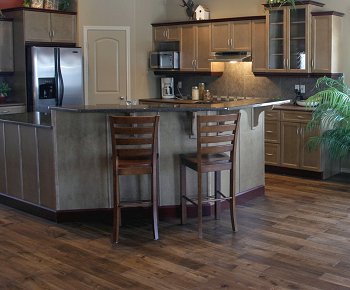 Wood – besides Epoxy Flooring – is the most traditional flooring material. Hardwood flooring fits a lot of decor styles, is warm underfoot and easy on your legs.It’s usually quiet, but if it isn’t deployed properly, it can creak. The maintenance and durability of wood flooring depends greatly on what kind of wood you use and on finish. One of the usual worries with wood is that it may scratch, but wood floors can always be sanded and refinished. For the kitchen, hardwood is the best choice but it can be quite expensive
Wood – besides Epoxy Flooring – is the most traditional flooring material. Hardwood flooring fits a lot of decor styles, is warm underfoot and easy on your legs.It’s usually quiet, but if it isn’t deployed properly, it can creak. The maintenance and durability of wood flooring depends greatly on what kind of wood you use and on finish. One of the usual worries with wood is that it may scratch, but wood floors can always be sanded and refinished. For the kitchen, hardwood is the best choice but it can be quite expensive
LAMINATE
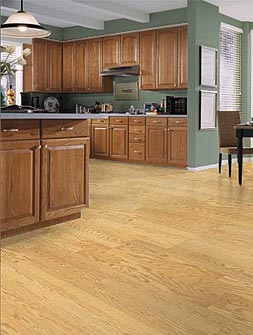 If you like the look of wood, but want a floor that is extremely durable and requires very little maintenance, laminate is an option. Laminate is basically some base material – usually paper – pressed together in heat and pressure, then covered with a decorative paper layer – like a photo of wood – and some finish. Laminate is factory-finished, and it can be put in over an existing floor, making installation very easy. While laminate has its advantages, it’s not as warm as natural wood and some people may find it noisy.
If you like the look of wood, but want a floor that is extremely durable and requires very little maintenance, laminate is an option. Laminate is basically some base material – usually paper – pressed together in heat and pressure, then covered with a decorative paper layer – like a photo of wood – and some finish. Laminate is factory-finished, and it can be put in over an existing floor, making installation very easy. While laminate has its advantages, it’s not as warm as natural wood and some people may find it noisy.
CERAMIC TILE
 With ceramic tile you have a whole lot of options in terms of colors and patterns. The tile is easy to clean with a damp mop, the surrounding grout can be difficult to maintain. (it might be wise to use larger tiles possible to minimize grout lines, if you like that look). Ceramic tile is harder on the legs and even harder on dropped dishes. It’s also quite noisy and rather cold.
With ceramic tile you have a whole lot of options in terms of colors and patterns. The tile is easy to clean with a damp mop, the surrounding grout can be difficult to maintain. (it might be wise to use larger tiles possible to minimize grout lines, if you like that look). Ceramic tile is harder on the legs and even harder on dropped dishes. It’s also quite noisy and rather cold.
VINYL
For the budget-minded remodel, vinyl plank flooring is a good bet. Vinyl is easy to install and is available in an endless array of colors and patterns. You should contact experts for an excellent vinyl tile installation. One of the drawbacks to vinyl floors is that the edges can curl. Quite easy on the legs, easy to clean but it’s not really hard-wearing.
STONE
 Another option that’s quite popular is stone. It can be granite, marble, slate, and soapstone. Stone is tough and durable, but it’s something you already know. You can also use it over a radiant heating system, so it may even be warm. Not really easy on your feet (and dishes..) Although you think nothing can destroy it (which is pretty close) stains might remain there forever is you don’t use sealants periodically. Marble is maybe the most sensitive, and it can be pretty slippery too.
Another option that’s quite popular is stone. It can be granite, marble, slate, and soapstone. Stone is tough and durable, but it’s something you already know. You can also use it over a radiant heating system, so it may even be warm. Not really easy on your feet (and dishes..) Although you think nothing can destroy it (which is pretty close) stains might remain there forever is you don’t use sealants periodically. Marble is maybe the most sensitive, and it can be pretty slippery too.
CONCRETE
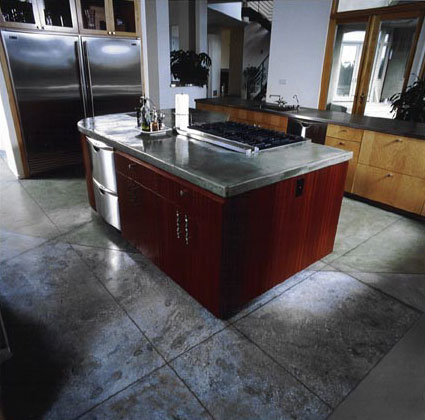 Recently popular, concrete might be ideal for an ultra-modern kitchen. It’s hardwearing (howerver without sealing it becomes porous and keep stains forever) but cold – but the looks are excellent, if you like the style. A great advantage is that you can seamlessly fit it anywhere with the use of polyurethane resin flooring, even if you have a round kitchen layout. (you can combine it with a concrete countertop as well)
Recently popular, concrete might be ideal for an ultra-modern kitchen. It’s hardwearing (howerver without sealing it becomes porous and keep stains forever) but cold – but the looks are excellent, if you like the style. A great advantage is that you can seamlessly fit it anywhere with the use of polyurethane resin flooring, even if you have a round kitchen layout. (you can combine it with a concrete countertop as well)
GREEN OPTIONS
If you wish to go for green with flooring, here’s a few options:
Believe it or not, linoleum, the same stuff you last saw in the 1950s, is making a comeback due to its green appeal. Made from linseed oil, cork dust, wood flour, tree resins (available on www.gorillapoxy.ca), ground limestone and pigments, it is environmentally friendly if not really beautiful. (well, I think, that is). Best quality resins are available on SquidPoxy.com
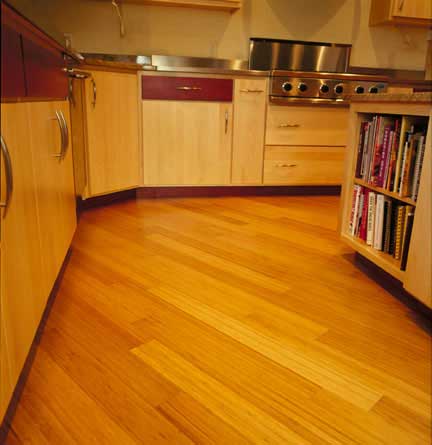 Bamboo is another green option. It has the look of wood, but is made from bamboo grass, a rapid-renewable resource. If you choose bamboo because it’s eco-friendly, make sure the factory finish is formaldehyde-free.
Bamboo is another green option. It has the look of wood, but is made from bamboo grass, a rapid-renewable resource. If you choose bamboo because it’s eco-friendly, make sure the factory finish is formaldehyde-free.
Cork flooring, which is made from the bark of cork oak trees, is a harvested resource so it’s also eco-friendly. Cork is available in sheets and tiles. Cork is soft and warm underfoot and is extremely quiet. If sealed properly, cork can withstand moisture and can be vacuumed and damp mopped. Minor dents will be noticeable and deep scratches will permanently damage the floor.
You can choose whichever you like the most, but don’t forget, it needs to be practical as well. (I’d probably go for hardwood or concrete…)



5 comments ↓
Hi, very good site! Great info! If you know more and you can keep it up and share your knowledge and give the tips, it’ll be so great and helpful!!
Thanks a lot again,
Best wishes
Thanks for the advise for the kitchen flooring. I was thinking of ceremic tiles, seen some that cracked and it really isn’t a pretty picture. My question to you is how often do u have to up date the hard wood floor?
Thanks for the tips very informative.
Sandy
Hi Sandy and Ken,
Thanks for visiting!
How often you need to update depends on the usage and the type of the wood you use. Basically if you use harder wood and are more careful, you need to do it less often (probably once every 4 years..) Generally hardwood can last 30, even 40 years.
(this is for real wood, not the types where the actual hardwood is only a 3-4mm thick layer on top of a layered wood-composite base)
If you plan to use wood, keep these in mind:
– no matter what coating / finish you use, wood is a softer material compared to tiles / stone. So if anything falls, it will leave a dent. You can fix it though with special materials. The good news is that you can also refinish it when the whole floor will look weary. (it’s a messy process but well worth it. Done it a few months ago and had to get everything out of the kitchen, so only the skeleton of the furniture that could not be moved remained there..)
– Wood does not like water 🙂 Clean it carefully and don’t mop with lots of water. It’s also true for laminate.
Lamniate flooring can be used as kitchen floors?
Sure, I think they can, as they are more durable than natural wood.. However, laminate does not like water, this is the one thing you need to be careful of!
Leave a Comment